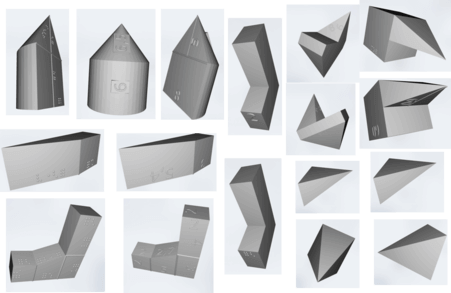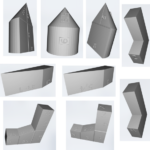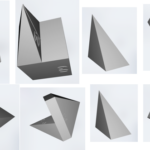
Technichal Specifications
How to use this exercise?
Calculation of volume and surface of composite bodies
Number of pieces of this exercise
16
General description
There are 12 models of composite geometric bodies. There are 6 different composite geometric bodies, each once are labeled with Braille (embossed) and another with black text (bright model, so that the font stands out well). The models 5 and 6 consist of two parts.
For Braille (computer or 8 point Braille) please note the following sizes:
A Braille character with its maximum of six (or eight) points is called a shape.
The size of the palpable Braille characters is 6 to 7 mm, the following dimensions are common:
• point distances 2.5 mm
• point thickness 1.5 mm (diameter)
• form distances 6 mm
• line spacing 10 mm
• point height (elevation) at least 0.4 mm (optimal height 0.5 – 0.7 mm)
See also: http://www.braille.ch/abstand.htm
An appropriate font I send with (EURO 800.ttf).
The script must either be printed sublimely and painted with a black pen or printed in two colors.
The color of the Braille models does not matter.
The models with black text should be printed in light colour so that the lettering stands out well.
Additional Material
Models used:
License Info
Attribution 4.0 International (CC BY 4.0) https://creativecommons.org/licenses/by/4.0/You are free to:
Share — copy and redistribute the material in any medium or format
Adapt — remix, transform, and build upon the material
for any purpose, even commercially.
Under the following terms:
Attribution — You must give appropriate credit, provide a link to the license, and indicate if changes were made. You may do so in any reasonable manner, but not in any way that suggests the licensor endorses you or your use.
No additional restrictions — You may not apply legal terms or technological measures that legally restrict others from doing anything the license permits.
Learning Specifications
How can the model be used in class?
Following the introduction of the various bodies (cuboid, cube, cone, cylinder, trapezium), the composite bodies will be discussed.
As part of the planned lesson, students will be provided with a learning counter for calculating volume and surface area with compound bodies.
I bring the models with me to the students.
There are two models for the 8 pupils. A model gets a blind girl, the other model is the visually impaired students in addition to oblique images available.
The individual tasks are differentiated into different difficulty levels, but can be edited in any order.
After the session, I will show and explain the students how these models were produced using 3D printing.
What benefits can its use have?
For the blind student, the models are irreplaceable for recording the task.
Slant images – even if they are embossed – can not be translated into a spatial idea.
For the visually impaired students, the models are very helpful, because several students have no spatial imagination and the information from the oblique images are difficult to remove.
Can it be used in other subjects?
Technical drawing, Art.

